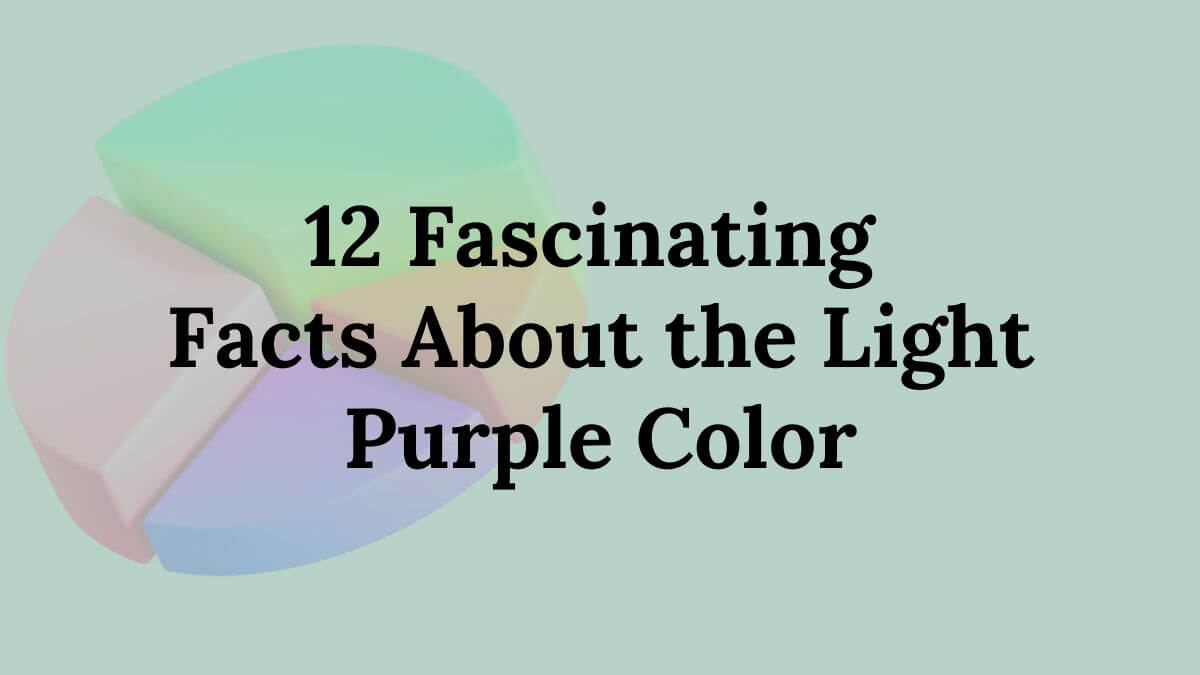Discover 12 fascinating facts about the light purple color- its meaning, history, and uses- in this friendly, educational guide for English learners.
Light purple is more than just a pretty shade – it’s a color with rich history, cultural meanings, and unique uses in art, fashion, and even language. Whether you’re learning English or teaching it, exploring color names like light purple can be both fun and educational. In this post, we’ll dive into twelve interesting facts about the light purple color and see how it appears in everyday English.
What Is the Light Purple Color?
The light purple color is a softer, paler variation of traditional purple, often described as calm, delicate, and romantic. It is created by mixing purple (which itself is made from red and blue) with white. The added white lightens the tone, producing a pastel shade that feels airy and gentle compared to deep or dark purples.
In everyday English, you might hear people use different names for the light purple color, such as lavender, lilac, mauve, or periwinkle. Each of these has a slightly different hue and personality:
1. Lavender is bluish and fresh.
2. Lilac has a pinkish undertone.
3. Mauve is muted and grayish.
4. Periwinkle blends light purple with soft blue.
For English learners, understanding the light purple color is more than just memorizing the name-it’s about recognizing how this color appears in real life and how it can be described in writing or speech.
For example:
She wore a light purple scarf that matched the flowers in her garden.
The sky turned light purple as the sun began to set.
This shade is often linked with elegance, calmness, and creativity. Because it sits between warm (red) and cool (blue) tones, light purple works well in both energetic and peaceful designs. Whether in fashion, art, or language, it adds a sense of grace without being overpowering.
The Origins and History of Light Purple
The light purple color has roots in the long and fascinating history of purple itself. In ancient times, purple dye was one of the most expensive substances in the world. It was made from a rare species of sea snail found in the Mediterranean, known as the murex. Producing just a small amount of dye required thousands of snails, which made purple fabrics a luxury only royalty and the wealthy could afford. This is why purple became known as the color of kings and queens.
Light purple shades, as we know them today, emerged much later. In earlier centuries, most purples were rich, deep, and dark because natural dyes could not easily produce pale tones. The idea of soft, pastel purples became popular during the 18th century, particularly in Europe. Wealthy families embraced lighter versions of purple for interior décor, clothing, and accessories, as they symbolized refinement, elegance, and a sense of calm sophistication.
A major turning point came in 1856, when a young chemist named William Henry Perkin accidentally discovered mauveine, the first synthetic purple dye, while trying to create a malaria treatment. This invention made purple-and eventually light purple-more affordable and accessible to ordinary people. Soon, light purple shades like lavender, lilac, and mauve began appearing in fashion, art, and home design.
During the Victorian era, light purple was a favorite color for women’s dresses and floral decorations, often associated with grace, femininity, and gentle beauty. In modern times, it remains a popular choice in weddings, branding, and art because of its timeless elegance and calming effect.
From its royal origins to its role in everyday life today, the light purple color has transformed from a symbol of wealth and exclusivity into a widely loved shade that still carries its rich historical charm.
Light Purple in English Language and Literature
In English language and literature, the light purple colour is often used to create imagery that feels gentle, romantic, or even mystical. Writers and poets choose this shade to set a mood, describe beauty in nature, or highlight elegance in clothing and surroundings. Because light purple is softer than deep violet or bright magenta, it carries a sense of subtlety and sophistication that fits well in descriptive writing.
For example, in creative writing, you might read lines like:
The horizon glowed in shades of light purple as twilight embraced the city.
Her gown, a delicate light purple, shimmered under the candlelight.
These examples show how light purple can make descriptions more vivid and emotional. For English learners, noticing these details in books or poems can help expand vocabulary and improve the ability to paint pictures with words.
In literature, specific names for light purple-like lavender, lilac, and mauve are also common. These words add precision and variety to descriptions. Instead of simply saying purple, an author can choose lavender to suggest freshness and peace, or mauve to suggest nostalgia or faded beauty.
Idiomatic expressions with purple tones also appear in English. While light purple itself is less common in idioms than darker shades, it still appears in phrases like lavender-scented dreams or mauve twilight, which add a poetic touch to writing.
Teachers can use excerpts from novels, poems, or short stories to help students identify color words and discuss how they affect tone and meaning. By learning how light purple is used in literature, English learners can strengthen both their vocabulary and their appreciation for descriptive language.
12 Fascinating Facts About the Light Purple Color Meaning, History, and Uses
1. Light Purple Color and Its Definition
The light purple color is a softer, paler version of traditional purple. In design and fashion, it’s often called lavender, mauve, or lilac. While purple itself comes from mixing red and blue, the light purple shade is created by adding white, making it softer and calmer.
In English, this color is often used to represent elegance, delicacy, and calmness. Words like pastel purple or soft violet are also common.
2. Historical Origins of the Light Purple Shade
The history of purple dates back to ancient times when it was made from rare sea snails. Because the dye was expensive, purple became a royal color. Light purple colors became popular later, especially during the 18th and 19th centuries in Europe, when pastel shades became fashionable.
In Victorian England, wearing light purple dresses was a sign of refinement and high social class.
3. Light Purple in Language and Literature
Writers often use the light purple color to create a gentle or romantic mood. For example:
The garden was filled with light purple blossoms swaying in the breeze.
Her dress, a shade of light purple, matched the calm evening sky.
For English learners, describing colors with specific words like lavender or mauve can make writing more vivid.
4. Symbolism and Meaning of Light Purple
In color psychology, light purple represents:
Peace and calmness
Spirituality and imagination
Femininity and grace
This makes it a popular choice for branding, home décor, and fashion. Teachers can use color meanings to help English learners connect vocabulary to emotions and concepts.
5. Light Purple in Art and Design
Artists love using light purple colors because they balance warm and cool tones. Impressionist painters often used lavender skies or lilac flowers to create depth and softness in their work.
For designers, light purple can be paired with:
White (clean and fresh look)
Gold (luxurious style)
Green (natural and calming effect)
6. Popular Names for the Light Purple Color
In English, there are many names for shades of light purple:
Lavender – soft, bluish purple
Lilac – pale purple with a pinkish tone
Mauve – dusty, grayish purple
Periwinkle – bluish – light purple
Learning these colour words helps students expand their vocabulary and understand descriptive writing better.
7. Light Purple in Fashion Trends
From royal gowns to modern streetwear, light purple colors have always been popular. Fashion designers often use this shade for spring and summer collections because it feels fresh and light. In English fashion vocabulary, you might see descriptions like lavender satin blouse or mauve evening gown.
8. Light Purple in Nature
Nature offers many examples of light purple colors:
Lavender flowers
Lilac blossoms
Certain orchids
The sky during sunset
Using nature-inspired color words in English writing helps learners make their descriptions more engaging and realistic.
9. Light Purple in Interior Decoration
Interior designers use light purple to create soft, relaxing spaces. It’s perfect for bedrooms, nurseries, or reading corners. The color pairs beautifully with creams, light grays, and natural wood tones.
In English décor vocabulary, you might read phrases like light purple throw pillows or lavender walls.
10. Light Purple and Cultural References
In Western cultures, light purple is often linked to romance and gentleness. In Japan, it can represent elegance and maturity. Understanding the cultural meanings of colors can help English learners use them appropriately in conversation and writing.
11. Learning Colour Names in English
Learning color names, including light purple, is an essential step for English learners. Teachers can create activities like:
Matching color names to pictures
Writing short stories that include color descriptions
Discussing the cultural meanings of colors
This approach makes vocabulary learning both fun and practical.
12. Fun Facts About Light Purple
The world’s first synthetic purple dye was mauveine, discovered by accident in 1856.
The lavender plant gets its name from the Latin word lavare, meaning to wash, because it was used in baths.
Light purple is often used in marketing for beauty and wellness brands to suggest calmness and elegance.
Read More:
Conclusion
The light purple color is much more than a shade – it’s a symbol of elegance, creativity, and peace. From its royal history to its role in modern fashion, design, and language, light purple continues to inspire people around the world. For English learners, exploring color names like light purple not only builds vocabulary but also deepens cultural understanding.

